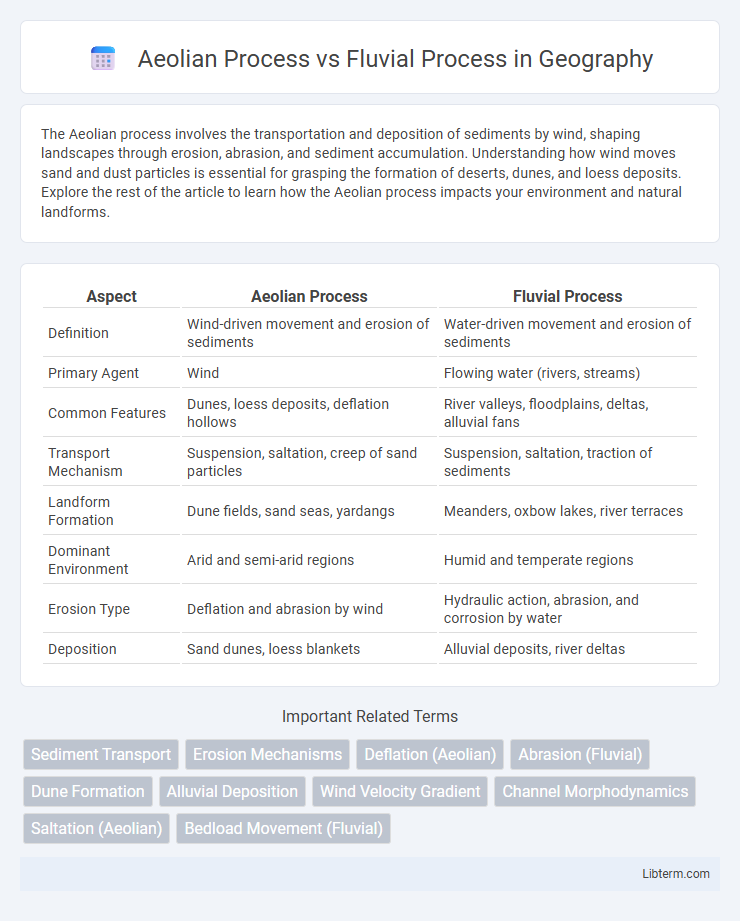The Aeolian process involves the transportation and deposition of sediments by wind, shaping landscapes through erosion, abrasion, and sediment accumulation. Understanding how wind moves sand and dust particles is essential for grasping the formation of deserts, dunes, and loess deposits. Explore the rest of the article to learn how the Aeolian process impacts your environment and natural landforms.
Table of Comparison
| Aspect | Aeolian Process | Fluvial Process |
|---|---|---|
| Definition | Wind-driven movement and erosion of sediments | Water-driven movement and erosion of sediments |
| Primary Agent | Wind | Flowing water (rivers, streams) |
| Common Features | Dunes, loess deposits, deflation hollows | River valleys, floodplains, deltas, alluvial fans |
| Transport Mechanism | Suspension, saltation, creep of sand particles | Suspension, saltation, traction of sediments |
| Landform Formation | Dune fields, sand seas, yardangs | Meanders, oxbow lakes, river terraces |
| Dominant Environment | Arid and semi-arid regions | Humid and temperate regions |
| Erosion Type | Deflation and abrasion by wind | Hydraulic action, abrasion, and corrosion by water |
| Deposition | Sand dunes, loess blankets | Alluvial deposits, river deltas |
Introduction to Aeolian and Fluvial Processes
Aeolian processes involve the erosion, transportation, and deposition of sediments by wind, shaping arid and semi-arid landscapes through features like dunes and loess deposits. Fluvial processes refer to the movement of sediments and landform development driven by running water in rivers and streams, influencing valley formation, floodplains, and delta systems. Both processes are critical in geomorphology, affecting sediment distribution and landscape evolution in contrasting environmental settings.
Defining Aeolian Processes
Aeolian processes refer to the transportation, erosion, and deposition of sediments by wind, predominantly occurring in arid and semi-arid environments where vegetation is sparse. These processes shape landforms such as dunes, loess deposits, and yardangs through mechanisms like deflation and saltation. Unlike fluvial processes, which involve water flow carving valleys and transporting sediments in rivers and streams, aeolian processes rely on air movement to redistribute fine particles over vast distances.
Defining Fluvial Processes
Fluvial processes refer to the movement and shaping of the Earth's surface by flowing water, primarily through rivers and streams. These processes include erosion, transportation, and deposition of sediments, which create distinct landforms such as valleys, floodplains, and deltas. Fluvial dynamics significantly influence soil fertility and landscape evolution, distinguishing them from Aeolian processes that involve wind-driven sediment movement.
Key Differences between Aeolian and Fluvial Processes
Aeolian processes primarily involve the erosion, transportation, and deposition of sediment by wind, shaping arid and semi-arid landscapes through features like dunes and loess deposits. Fluvial processes are driven by the movement of water in rivers and streams, causing erosion, sediment transport, and deposition that form valleys, floodplains, and deltas. Key differences include the medium of transport--wind versus water--the sediment size typically moved, with aeolian processes favoring finer particles, and the distinct landforms each process creates.
Mechanisms of Sediment Transport
Aeolian processes transport sediment primarily through wind-driven mechanisms such as saltation, suspension, and surface creep, which effectively move fine particles like sand and dust over arid and semi-arid landscapes. Fluvial processes involve sediment transport by water flow in rivers and streams, utilizing traction, saltation, suspension, and solution to move a diverse range of particle sizes from clay to boulders downstream. The key distinction lies in the medium, where Aeolian transport favors dry, loose sediments influenced by air turbulence, while fluvial transport relies on hydraulic forces and channel morphology to mobilize sediments.
Landforms Created by Aeolian Activity
Aeolian processes shape distinctive landforms such as sand dunes, loess deposits, and yardangs through wind erosion, transport, and deposition. Sand dunes, formed by the accumulation of wind-blown sand, vary in shape from crescentic barchans to linear and star dunes, depending on wind patterns and sediment supply. Yardangs emerge as streamlined ridges sculpted by persistent wind abrasion, while loess deposits consist of fine silt particles transported over long distances, creating fertile soils.
Landforms Shaped by Fluvial Activity
Fluvial processes shape diverse landforms such as valleys, floodplains, river terraces, and deltas through the erosion, transportation, and deposition of sediments by running water. Meandering rivers create oxbow lakes and point bars, while braided rivers form interconnected channels and bars from abundant sediment load. These dynamic fluvial landforms reflect the complex interactions of water flow, sediment type, and landscape slope.
Environmental Factors Influencing Each Process
Aeolian processes are primarily influenced by wind strength, sediment availability, and surface dryness, which promote the erosion, transportation, and deposition of fine particles in arid and semi-arid environments. Fluvial processes depend on water flow velocity, discharge, gradient, and sediment load, shaping landscapes through river erosion, transportation, and sediment deposition in various climatic zones. Vegetation cover and human activities also play significant roles in modifying both aeolian and fluvial dynamics by stabilizing sediments or altering natural flow patterns.
Human Impacts on Aeolian and Fluvial Systems
Human activities significantly influence both aeolian and fluvial processes, with land use changes such as deforestation and agriculture exacerbating sediment mobilization in fluvial systems and increasing dust emissions in aeolian systems. Urbanization and infrastructure development alter natural water flow and sediment transport, leading to increased erosion, sedimentation, and habitat disruption in rivers and streams. In aeolian environments, overgrazing and vegetation removal intensify wind erosion, resulting in dust storms and degradation of soil quality, which affect air quality and agricultural productivity.
Conclusion: Comparing Aeolian and Fluvial Significance
Aeolian and fluvial processes each play vital roles in shaping Earth's surface, with aeolian processes dominating arid and semi-arid environments by transporting and depositing fine sediments through wind action, while fluvial processes primarily sculpt landscapes via river and stream flow, influencing erosion, sediment transport, and deposition in diverse climates. The significance of aeolian processes is most evident in desert dune formation and loess deposits, whereas fluvial processes are crucial for creating river valleys, floodplains, and deltaic systems. Understanding the interplay between these processes provides essential insights into sedimentary environments, soil development, and landscape evolution.
Aeolian Process Infographic

 libterm.com
libterm.com